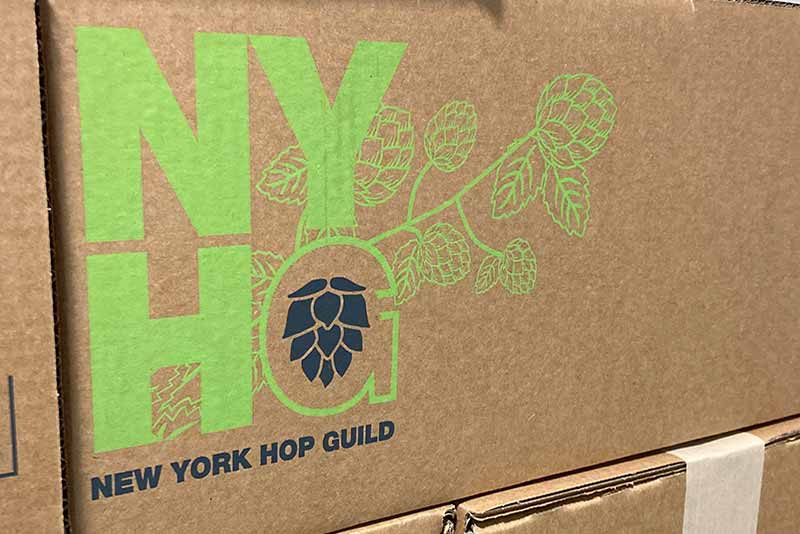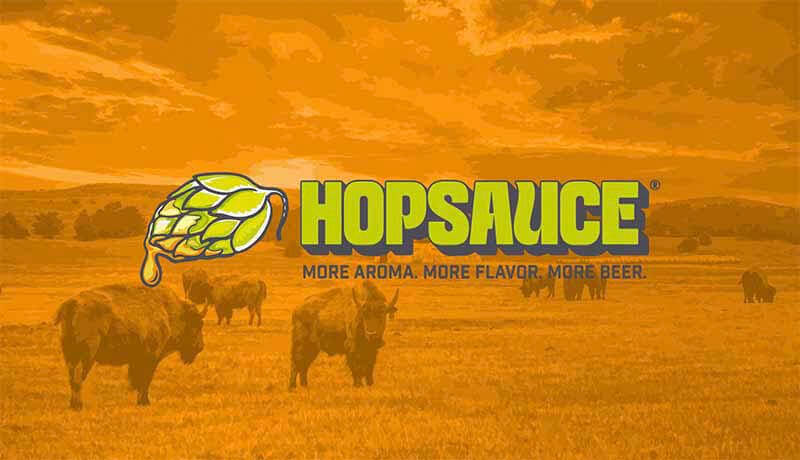
When brewers across the U.S. think of hop production in North America, they immediately think of the Pacific Northwest in states like Washington, Oregon, and Idaho. But that’s not the only region in this vast, lush country that grows one of beer’s most crucial ingredients. The HOPGUILD out of New York proves that growers on the East Coast are every bit as essential to making excellent craft beer as their partners on the West Coast.
We chatted with The HOPGUILD Co-Owner Chris Holden to learn how The HOPGUILD came to be, its mission, how it chooses its growers, some of its products, and its plans for the future.
What We’ll Cover in This Piece:
Affordable, Industry-Leading Brewery Software
What Is The HOPGUILD Origin Story?

Hops from Crooked Creek Hops | Photography courtesy of The HOPGUILD
Chris Holden and Chuck Rhoades started The HOPGUILD after crossing paths in 2017. Owners of New York-based hop farms, Crooked Creek Hops and Willet Hop & Grain, respectively, Holden and Rhoades struck up a conversation while touring other hop processing facilities in the Pacific Northwest.
“About three months after that trip, Chuck asked if I was interested in running his farm, but I had my farm, so I declined,” Holden says.
Several weeks later, the two picked up the thread again but morphed it into combining their efforts.
“We wanted to bring New York-grown hops to breweries,” says Holden, who didn’t immediately act on the plan.
In early 2018, Rhoades pressed Holden about launching that business, and that summer, they finally applied for their LLC name, New York Hop Guild.
“By harvest 2018, we decided to pull the trigger and started selling hops under The HOPGUILD in September 2018,” Holden says.
What Is the Mission of The HOPGUILD?

Photography courtesy of The HOPGUILD
The HOPGUILD is all about sustainability, starting with the growers in New York and expanding to the grower partnerships they’ve developed in the Pacific Northwest, Germany, and New Zealand.
“The mission [when we started] was to bring New York hops to more of a national marketplace and to help the growers here in New York State to grow to a sustainable size to be full-blown businesses,” Holden says. “That is still the mission statement, though it’s slightly different because we work with some growers [worldwide].”
Beyond that, Holden says the intent is always to sell high-quality hops.
What Is The HOPGUILD Selection Process for Hop Growers?

Hops from Beach Hill Hops | Photography courtesy of The HOPGUILD
Holden says this was seamless for The HOPGUILD since both he and Rhoades had connections from their personal farms.
“It was an easy phone call to ask the growers to switch from the previous [business model] to the new one,” Holden says. And for the growers who partner with The HOPGUILD, once the harvest is done, they wash their hands clean.” In other words, The HOPGUILD buys hops directly from the growers post-harvest and sells them to breweries.
Some of the other growers took time to get on board, but Holden says those are among their best producers. Currently, The HOPGUILD has thirteen growers based in New York, but that number fluctuates between eleven and thirteen.
“We got six growers that have been with us since the beginning,” Holden says.
Holden says he also has long-standing relationships with some growers outside of New York, specifically in the Pacific Northwest, and “they invited us in with open arms, catered to us, and allowed us to have their quality hops.”
“The same with our German growers for the varieties of hops we wanted,” Holden says. “We hooked up with them because their story was the same as ours: quality over quantity.”
All told, The HOPGUILD has twenty growers in the U.S.—thirteen in New York, two in Michigan, three in Washington, one in Montana, and one in Idaho—three in Germany, and two in New Zealand.
Which Hops Are The HOPGUILD Excited About This Year?

Hops from Beach Hill Hops | Photography courtesy of The HOPGUILD
Unlike other regions with farms in one cluster, New York growers are spread out. Sometimes, that leads to certain areas performing well while others have down years. But Holden says that, in New York, the 2023 harvest was great statewide.
“We had a lot of nice Cascade this year across the state,” Holden says. “Across the board, everyone did well, and the quality was high.”
Holden says New York Cascade, New York Vista, and New York Triumph hops performed well in the recent harvest. For The HOPGUILD hops outside New York, Holden says Anchovy and Ahhhroma did exceptionally well.
“Anchovy has been pretty steady,” says Holden, adding that the hop growers are incredibly passionate about their process. “I always like when a grower is ecstatic about a hop. If they like growing it, that’s going to show in the hop.”
The Montana-based Ahhhroma is a high-Alpha, high-oil hop that Holden also speaks of highly.
“That hop has been well underrated for years now,” he says. “It does really well in IPAs.”
As for 2024, Holden says he’s excited about working on a USDA experimental hop, the name of which he couldn’t divulge. The hope is to broaden the acreage of the hop throughout New York.
“A lot of brewers [experimenting with the hop] are saying they like how it expresses next to Saaz,” Holden says. “It works well on its own, but when paired together with Saaz, it makes it more drinkable and enjoyable.”
Other varietals Holden pointed to included German Tango, Tonatiuh, and New York Excelsior.
The HOPGUILD Also Offers HOPSAUCE Hop Extract

Photography courtesy of The HOPGUILD
Last year, we wrote everything you need to know about HOPSAUCE. For a quick recap, The HOPGUILD created HOPSAUCE as a flowable hop product used during the whirlpool—alongside a dash of T-90 pellets—or as a dip hop.
“HOPSAUCE came about during the hemp craze in New York,” Holden says. “We did experimentation along with hemp farmers, and when that craze went away, we gained access to a CO2 extraction system and finalized the HOPSAUCE product.”
Holden says the best way to maximize the aromatics of the hops is to run the system “low and slow.”
The product has nine varietals, including Amarillo, NY Chinook, NZ Nelson Sauvin, NZ Rakau, Zappa, NY Cascade, Cashmere, Centennial, NY Excelsior, and NZ Motueka. Holden says that HOPSAUCE differs from similar products in the market because they have “more fresh aromatics and are more true-to-type to the pellet.”
“It’s our processing and the way we do it,” Holden says.
Holden recommends a six-to-one ratio of HOPSAUCE to T-90 pellets. He says one kilogram of HOPSAUCE for every 13.2 pounds of pellets.
“Replacing that amount, you will see roughly sixteen gallons or more going into the fermenter,” Holden says.
According to Holden, the product will likely increase the brewery’s profit and free up storage space in the cold room.
What Innovations Do The HOPGUILD Expect to Release in 2024?
Holden says they are in the latter stages of the R&D process for an all-in-one hop extract.
“It’s definitely for lagers. It’s big and burly,” Holden says. “The goal with this one is to be used for all hot-side additions and replace one hundred percent of the kettle hops.”
He adds, “The goal is to see if it’s sustainable across the state. If it is, there is potential to release it.”
Holden expects that, if all goes to plan, The HOPGUILD will release NOBLESAUCE at this year’s harvest.
Beyond that, Holden says they are working with brewers on ten different products at various stages of the R&D process.
“We have a lot of experimentation going on,” he says, “to help out with carbon footprint and profitability for brewers.”
What Is the Future of The HOPGUILD?

Photography courtesy of The HOPGUILD
Holden says the long-term vision is the same as the goals here and now.
“We want to continue to help growers get to a size where they are a sustainable business in New York,” Holden says.
But the company’s goals are even loftier.
“We want to be more of a leader in the industry from a production standpoint on pellet and extraction,” Holden says. “Also to be the East Coast hub as things begin to regionalize.”



